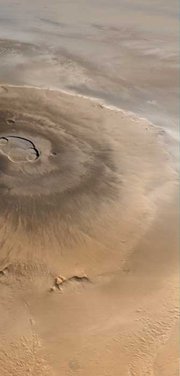Olympus Mons
|
|
Olympus Mons (Latin, "Mount Olympus") is the tallest known mountain in our solar system, located on the planet Mars at approximately Template:Coor d. In the days before space probes revealed its identity as a mountain, Olympus Mons was known to astronomers as the albedo feature, Nix Olympica ("Snows of Olympus").
| Contents |
General description
The central edifice stands 27 kilometres (88,600 feet) high over its base (about three times the height of Mount Everest above sea level and three times the height of Mauna Loa above its base); it reaches 25 km above the mean surface level of Mars, since it stands in a two-kilometre-deep depression. It is 540 km (335 miles) in width, flanked by steep cliffs, and has a caldera that is 85 km (53 miles) long, 60 km (37 miles) wide, and up to 3 km (1.8 miles) deep with six overlapping pit craters. Its outer edge is defined by an escarpment up to 6 km (4 miles) tall unique among the shield volcanoes of Mars.
The size of Olympus Mons is so great (roughly the size of the American state of Missouri) that a person standing on the surface of Mars would be unable to view the profile of the volcano even from a distance as the curvature of the planet would obscure such detail. The only way to view the mountain properly is from orbit.
An occasional misconception is that the top of Olympus Mons is above the Martian atmosphere. The atmospheric pressure at the top is about 2% that of average Martian surface pressure; by comparison the atmospheric pressure at the summit of Mount Everest is about 25% of that at sea level, even so airborn martian dust is still present and high altitude carbon dioxide-ice cloud cover is still possible at the peak of Olympus mons, though water-ice clouds are not. Although the Martian average atmospheric pressure is less than 1% of that seen on Earth, the much lower gravity on Mars allows its atmosphere to extend much higher.
Volcanism
Olympus_Mons_caldera.jpg
Olympus Mons is a shield volcano, the result of highly fluid lava flowing out of volcanic vents over a long period of time, and is much wider than it is tall; the average slope of Olympus Mons' flanks is very gradual. In 2004 the Mars Express orbiter imaged lava flows on the flanks of Olympus Mons that appear to be only 2 million years old, very recent in geological terms, suggesting that the mountain may yet have some ongoing volcanic activity.
The Hawaiian Islands are examples of similar shield volcanoes on a smaller scale (see Mauna Loa). The extraordinary size of Olympus Mons is likely due to the fact that Mars does not have tectonic plates. Thus, the crust remained fixed over a hot spot and continued to discharge lava, bringing the volcano to such a height.
Surroundings
Olympus Mons is located in the Tharsis bulge, a huge swelling in the Martian surface that bears numerous other large volcanic features. Among them are a chain of lesser shield volcanoes including Arsia Mons, Pavonis Mons and Ascraeus Mons, which are small only in comparison to Olympus Mons itself. The land immediately surrounding Olympus Mons is a depression in the bulge 2 km deep.
The volcano is surrounded by a region known as the Olympus Mons Aureole (Latin, "Circle of Light") with gigantic ridges and blocks extending 1000 km (600 miles) from the summit that show evidence of development and resurfacing connected with glacial activity. Both the escarpment and the Aureole are poorly understood. In one theory this basal cliff was formed by landslides and the Aureole consists of material piled up at the bottom of these landslides.
External links
- Astronomy Picture of the Day (http://antwrp.gsfc.nasa.gov/apod/ap040526.html) 26 May 2004
- Western Flank of Olympus Mons and Aureole (http://www.esa.int/SPECIALS/Mars_Express/SEM59O67ESD_0.html)
- Volcanism on Mars (http://volcano.und.nodak.edu/vwdocs/planet_volcano/mars/Overview.html)
- Key ideas, pictures, and maps on the Olympus Mons (http://www.hkshum.net/Olympus/)de:Olympus Mons
fr:Olympus Mons ko:올림푸스 산 (화성) he:אולימפוס מונס nl:Olympus Mons ja:オリンポス山 (火星) pl:Olympus Mons pt:Monte Olimpus sv:Olympus Mons

